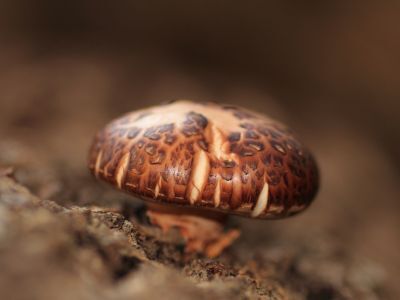Medicinal Mushrooms: Nature's Great Recyclers
authored by Taylor Appel, MSCN, RH (AHG)

Beyond their delicious flavor and nutritious make-up, mushrooms, just like plants, possess highly medicinal compounds that have been utilized for centuries across many cultures worldwide. Mushrooms have more recently been adapted for modern use as myotherapies and nutraceutical products alike, allowing safer and easier access to higher quality specimens and more potent medicinal species. Advancements in mycology and various medical research efforts have illuminated the true therapeutic potential of specific mushroom species and their effectiveness in treating both acute and chronic conditions, especially those impacting the immune system directly.1 Ethnobotanical history and modern research surrounding medicinal mushrooms highlight the therapeutic potential of these complex organisms. This article explores the broad range of pharmacological and nutritional benefits medicinal mushrooms offer.
A Deeper Dive into Mushrooms
Mushrooms are known as the great recyclers, helping to aid in the natural decomposition process of plants, animals, and just about any dead or dying entity (including foods - think mold and yeast). Mushrooms, often referred to as fungi, are just like plants, having various parts to their anatomy. Thousands of different species grow worldwide that are used for diverse medicinal purposes. It is estimated that there may be up to 22,000 different mushroom species discovered, with only around 30 of those being cultivated for edible uses, and a mere 15 of those species that are wildly foraged around the world.1,2

Mushrooms consist of three main parts: 1) mycelium, a web-like network of underground roots that connect mushrooms to each other and allow them to communicate for better survival, 2) a fruiting body, which is the part of the mushroom growing above ground and more widely harvested and used for medicinal purposes, and 3) the spores of the mushroom, which are mainly used for mushroom reproduction. These are usually found on the above-ground portion, or fruiting body, of the fungi.1 As the field of mycology grows, we are able to better understand the potential medicinal applications for these incredible organisms and how they may support our everyday health.
What Makes a Mushroom “Medicinal”?
Each species of mushroom contains a unique make-up of bioactive metabolites, including myco-polysaccharides (also referred as alpha- or beta-glucans), terpenes, nucleotides, alkaloids, sterols, vitamins, fatty acids, and other nutritional and medicinal compounds that contribute to their specified therapeutic effects.2,3 The bioactive compounds in mushrooms have been most notably used for their immune-supporting effects, helping to both modulate and strengthen the immune system response. Other benefits of medicinal mushrooms include, but are not limited to, being an antioxidant, adaptogen, anti inflammatory, cytotoxic, anticancer, antidiabetic, hepatoprotective, neuroprotective, antimicrobial, having prebiotic properties, and so much more.3,4 The research to substantiate these claims is abundant, although the push for more human trials is always a priority so we can further expand our therapeutic applications of these medicinal fungi in a safe and effective manner.

Current research has unearthed a variety of medicinal applications of numerous mushroom species, with the more traditional varieties taking the mainstage, such as those popularly utilized within various Asian cultures for culinary and medicinal practices. Mushrooms were utilized fresh or dry, in soups, stews, decoctions (longer infusions), powder formulations, and many other ways throughout Traditional Chinese Medicine history, and in Western herbalism as well. Many of these traditional preparations are still used today.
Reishi, Turkey Tail, Cordyceps, Shiitake, and Poria are just a very small sample of the more popularly used medicinal mushrooms referenced in traditional texts for both clinical and in-home uses.1,5 Generally, medicinal mushrooms require a more substantial extraction process to successfully produce a viable medicine, although consuming the entire fruiting body may also be warranted depending on the therapeutic needs of an individual. In fact, many practitioners and traditionalists claim that consuming the entire mushroom (fruiting body) is the most effective way to tap into the fungi’s medical potential, but just like botanical medicines, mushrooms each require a unique handling procedure depending on their species and extraction needs to successfully transform them into medicines.5

Quality of Medicinal Mushrooms Products and Supplements
Sourcing, quality, and preparation of medicinal mushroom products directly impacts the type and amount of bioactive compounds present. The true therapeutic potential of medicinal mushrooms comes directly from the source itself – i.e, the environment (ideally mimicking natural cycles and climate) in which the mushroom is grown, harvested, and processed. Unfortunately, finding therapeutic and reputable mushroom products and supplements can be a challenge for practitioners and individuals. This is due in large part to the lack of third-party testing and consistent quality standards among many manufacturers. In addition, manufacturers will often use the wrong part or type of mushroom needed to substantiate therapeutic claims made in their consumer marketing. Thankfully, trustworthy medicinal mushroom companies do exist, with Nammex® Organic Mushroom Extracts being my favorite source for the highest quality mushroom products.3,5 If you’re looking to find a quality medicinal mushroom supplement, look for one containing Nammex® extracts.
Brands like Natura Health Products, formulated exclusively by Donald Yance, have paved the way for reputable medicinal mushroom products. Their product Mushroom Synergy® combines a host of medicinal mushrooms, alongside other traditional plant medicines, to synergistically create a formula that enhances both cellular and immune response, promotes healthy heart, kidney, and neurological function, and also provides substantial protective, modularity, and restorative properties.6 The mushrooms in this product are from Nammex®, which is another reason why I like this formula.

The Future of Medicinal Mushrooms
A resurgence of interest in medicinal mushrooms has emerged with the trend toward holistic health and healthy living. Modern research efforts, including numerous double-blind, randomized trials, have been successful in documenting the therapeutic effects of many mushroom species. A few of these extraordinary findings are highlighted in the International Journal of Molecular Sciences entry titled, Medicinal Mushrooms: Bioactive Compounds, Use, and Clinical Trials, where the thorough overview of numerous, more recent, medicinal mushroom studies are detailed and analyzed.1
Most notably, the use of medical mushrooms as an integrative cancer therapy has become widely popular due to the cytotoxic, or anti-tumor properties, and antioxidant effects that some of these highly medicinal species possess. The cytotoxic effects observed in many fungi species has led to incredible advancements in complementary cancer care models, including some clinical trial results depicting beneficial impacts on quality of life and the lowering of adverse reactions from chemotherapeutic agents. Additionally, positive effects on the anti-tumor and immunomodulatory processes have also been noted through the observation of increased activity of natural killer cells, a protective, immune-modulated response to cancer.1,4
To close, medicinal mushrooms have many historical uses and research-backed health benefits. They are a supportive therapeutic for immune function and overall health optimization, and can be used complementary to conventional medicines and alongside other holistic modalities, such as a healthy diet, regular exercise, and stress reduction techniques.
Join the Mederi Center community by signing up for our email list! We send several emails a month with product promotions for patients, practical tips for healthy living, blogs written by our practitioners, information about events, and other news. You can unsubscribe at any time.
References
- Osellame Venturella G, Ferraro V, Cirlincione F, Gargano ML. Medicinal Mushrooms: Bioactive Compounds, Use, and Clinical Trials. Int J Mol Sci. 2021;22(2):634. Published 2021 Jan 10. doi:10.3390/ijms22020634
- Wasser SP. Medicinal mushroom science: Current perspectives, advances, evidence, and challenges. Biomed J. 2014;37(6):345-356. doi:10.4103/2319-4170.138318
- Redefining medicinal mushrooms: A new way to gauge quality in medicinal mushrooms. Nammex. (2019, January 29). https://www.nammex.com/redefining-medicinal-mushrooms/
- Jeitler M, Michalsen A, Frings D, et al. Significance of Medicinal Mushrooms in Integrative Oncology: A Narrative Review. Front Pharmacol. 2020;11:580656. Published 2020 Nov 11. doi:10.3389/fphar.2020.580656
- Zaremba, CNP, K., & Name. (2023, August 15). Top 8 medicinal mushrooms for immune health. Fullscript. https://fullscript.com/blog/mushrooms-for-immune-health
- Mushroom Synergy - Natura Health Products. (n.d.). https://www.naturahealthproducts.com/content/product-pdf/Mushroom-Synergy-PS.pdf


